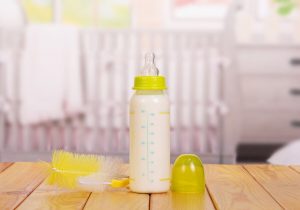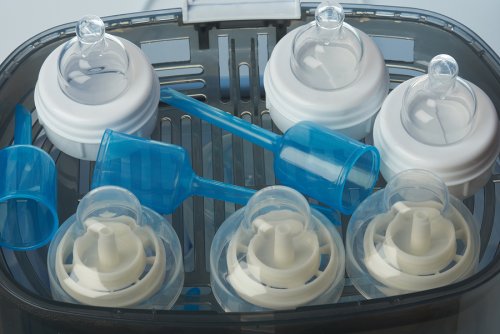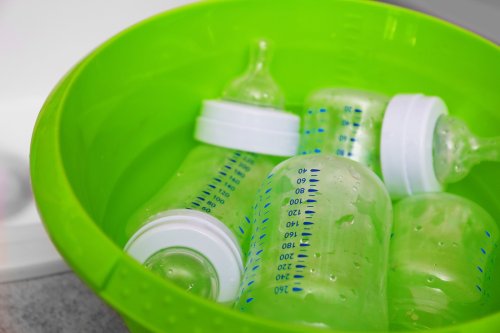How to Properly Wash Baby Bottles

All mothers want to do the best job possible and each new task represents a small challenge that we hope to overcome successfully. Among them is knowing how to properly wash baby bottles and whatever other elements we use to feed our little ones.
There’s a lot of information on how to correctly wash baby bottles and other frequently used baby items. In fact, there are even certain misconceptions regarding the issue.
Despite the differing opinions and methods, what’s true is that keeping these items free from germs and bacteria is paramount.
We must remember that babies have an underdeveloped immune system. Therefore, their bodies are unable to defend themselves naturally from possible bacteria.
Since they have a tendency to stick everything in their mouths, they’re at high risk of infection. Therefore, deep cleaning each item – especially during the first months of life – is something we can’t leave up to chance.
How to wash baby bottles properly
Many techniques have come to light regarding how to wash baby bottles correctly. But the truth is there’s no one perfect formula when it comes to this task, nor is there a manual that indicates what we should or shouldn’t do when washing these utensils.
However, we must keep in mind that, after feeding our babies, we should wash his or her bottle. Making sure to get rid of any remaining milk or formula will help prevent the multiplication of microorganisms that are harmful to our little one’s health.
Sterilization is a controversial topic when it comes to bottle and nipple hygiene. Some people affirm that this procedure isn’t important, and that washing items with soap and water is sufficient.
However, sterilization is necessary on certain occasions, especially before using these utensils for the first time.

There are two simple methods that we can put into practice to sterilize our baby’s feeding items:
Using the microwave
To carry out this type of procedure, we must possess a sterilizer made especially for the microwave. This type of sterilizer consists of a bowl with holes in the top or the base where we add water and the items we want to sterilize.
Before carrying out this method, you should make sure that the bottle or other items don’t have a triangle with the letters “PA.” If so, this sterilization method could cause damage to the utensils.
Cold steriliztion
To implement this technique, you must use specific products that are available in different forms, such as pills or liquids.
First we dissolve the product in water that has been previously boiled. The product instructions will indicate a specific wait time, after which we can remove the items and rinse them with cold water.
You should never use the same pill for more than one sterilization. Rather, you should use a new pill each time you sterilize your baby’s items.
“We must remember that babies have an underdeveloped immune system. Therefore, their bodies are unable to defend themselves naturally from possible bacteria.”
Washing with soap and water: Is this enough?
This is the most common and efficient method that mothers use, since it involves items that are always on hand. The procedure is simple and practical.
As soon as your baby is done feeding, you wash his or her bottle to keep the milk or formula from sticking. We also do the same with bottle nipples, lids, etc.
When washing baby bottles, we must thoroughly scrub every surface with a soapy sponge or brush. This is especially important when it comes to rims and the areas where the bottle and lid twist together.
There are special brushes that make the task of removing residue much easier. Thanks to their design, we can reach places that are impossible to reach with our hands and sponge.

After washing, it’s best to allow all parts to air dry in a ventilated area. You can arrange them upside down so that all of the water runs out and to avoid using dish cloths for drying. These towels can host a number of microorganisms that can make your baby ill.
When everything is completely dry, store them in an area that is free of moisture and dust. If your baby uses several bottles, then you should use the same procedure with all of them. That way, you can be sure that all items are free of germs and bacteria.
Lastly, remember that there is no one protocol regarding how to wash baby bottles. Just the same, you can use various ideas and tips and adapt them to your circumstances.
Keep in mind that there are very budget-friendly options that can help you maintain optimal hygiene.
All cited sources were thoroughly reviewed by our team to ensure their quality, reliability, currency, and validity. The bibliography of this article was considered reliable and of academic or scientific accuracy.
Urgellés-Pérez, Y., & Abellas-La O, M. A. (2012). Algunas consideraciones sobre la alimentación del lactante para la conservación de su salud bucal. MEDISAN.
Aguayo, J., Serrano, P., Calero, C., Martínez, A., Monte, C., & Rello, C. (2000). Lactancia materna. Salud Entre Todos.
This text is provided for informational purposes only and does not replace consultation with a professional. If in doubt, consult your specialist.








